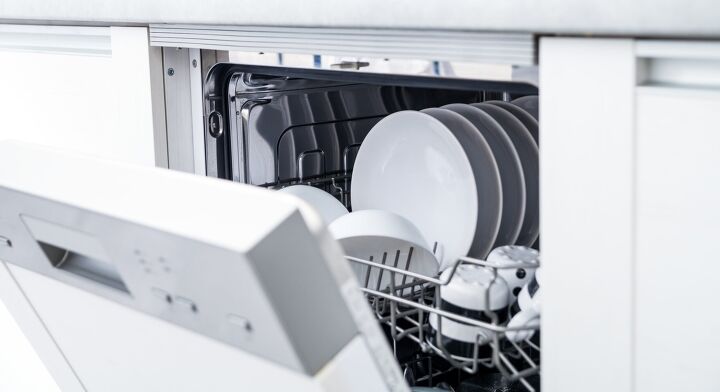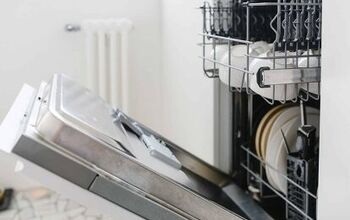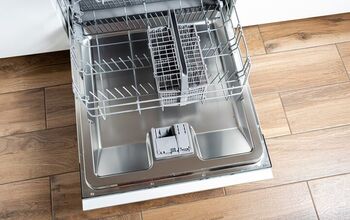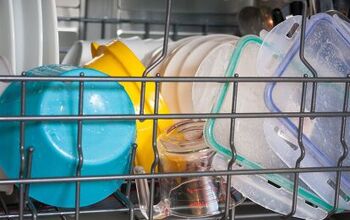Is A Dishwasher Air Gap Required In Washington State? (Find Out Now!)

Since your dishwasher drains into your kitchen’s plumbing system, there is a small possibility that dirty drain water could be siphoned back into your dishwasher. If this happens, it can contaminate your clean dishes or potentially be drawn into your freshwater supply. To prevent this from happening, most building codes require that some sort of air space be created in the dishwasher drain hose.
In some jurisdictions, installing a high loop is the minimum requirement, while other areas require an air gap to be installed alongside new dishwashers. For this reason, you may find yourself wondering: “Is a dishwasher air gap required in Washington State?”
According to Washington State Building Code, both domestic and commercial dishwashers must discharge indirectly through an air gap. Continue reading to learn more about what a dishwasher air gap is, how they work, and why so many state building codes are requiring them nowadays.
Do You Need a Permit Service?
Get free, zero-commitment quotes from pro contractors near you.

What is a Dishwasher Air Gap?
A dishwasher air gap is a fitting that is mounted roughly two inches above your sink and serves to prevent contaminated water from siphoning back into your dishwasher via backflow from the drain. Air gaps are simple tools for ensuring that wastewater and various contaminants never make their way back into your clean water supply.
After running your dishes through your dishwasher, the last thing you want is for them to come out covered in gunk and food particles from your blocked garbage disposal. The purpose of air gaps is to separate the hose that runs dirty water from the hose that runs to your drain. With these two hoses never crossing paths, the risk of wastewater getting into your clean dishwasher is eliminated.
Consider the space between your kitchen faucet and the rim of the sink as an air gap. Should your garbage disposal get clogged and your sink overflow with dirty water, water will eventually spill over the counter but will not reach the mouth of your faucet. As such, the distance between the rim of the sink and the mouth of the kitchen faucet (a literal gap of air) ensures that the dirty water doesn’t backflow into the faucet and pollute your potable water.
What is backflow and how does it work?
Simply put, backflow is the unsolicited reversal of water flow. It causes contaminants and polluted water to literally flow backwards into your clean water supply. As such, dishwasher air gaps are a type of backflow prevention. In the plumbing world, the point where wastewater could possibly contaminate the water supply is known as a cross-connection.
These cross-connections can result in backflow whenever there is a significant change in pressure. For instance, if your sink drain gets backed up, the hose that leads to the drain will start to redirect water back into your appliances. Therefore, without an air gap installed, your dishwasher can become flooded with wastewater.
How Does a Dishwasher Air Gap Work?
With a dishwasher air gap, two branches of hose are separated with a physical gap of air to eliminate the risk of cross-contamination between the drain and the dishwasher. One branch of the air gap fitting is connected to the air gap from the dishwasher, while the other branch goes from the air gap to the garbage disposal.
The hose that carries the dirty water from the dishwasher leaves the dishwasher, curving upward. At the peak of this curve, the branch ends and the water comes out of the tube’s open mouth, through the air gap, and into the second branch. This second branch is then responsible for carrying the wastewater down to the designated drainage location.
These two branches are both installed underneath your kitchen sink or countertop. You’ve likely seen an air gap before, as air gap fittings have a decorative heading that protrudes above the counter. They’re usually found next to your kitchen faucet, sprayer, or soap dispenser. This decorative heading contains the vertical air gap, which is notched with holes that release water into your sink if the drain ever gets clogged or the tubing becomes blocked.
Do I Need a Dishwasher Air Gap?
Overall, air gaps are the most effective way to prevent your dishwasher from getting cross-contaminated with waste. That said, if your goal is to protect your dishwasher from becoming overrun with tainted water, you should install an air gap. Although air gaps may not be the only method to prevent backflow into your dishwasher, they are the only method that has been proven to be effective under all circumstances.
Since air gaps do not have any moving components, they cannot fail. They operate on the principle of physics, as water cannot simply travel backwards through an unpressurized gap of air. Other backflow prevention techniques only dissuade cross-contamination, while dishwasher air gaps promise this protection.
Because of the incredible reliability of dishwasher air gaps, many plumbing codes across the U.S. are now requiring all dishwashers to be installed with an air gap.
Is a Dishwasher Air Gap Required in Washington State?
According to Washington State Building Code Section 414.3 on Drainage Connection:
“Domestic dishwashing machines shall discharge indirectly through an air gap fitting in accordance with Section 807.3 into a waste receptor, a wye branch fitting on the tailpiece of a kitchen sink, or dishwasher connection of a food waste disposer. Commercial dishwashing machines shall discharge indirectly through an air gap.”
In other words, it is required for all dishwashers – whether residential or commercial – to have physical air gaps in Washington State. If you choose to forgo installing an air gap, your home will not be up to code. Then, when it comes time to sell your home, your inspector will require you to have an air gap installed.
Other states that have adopted similar mandatory residential dishwasher air gap installation procedures include California, Minnesota, Oregon, and Hawaii.
Do You Need a Permit Service?
Get free, zero-commitment quotes from pro contractors near you.

How to Install a Dishwasher Air Gap
Fortunately, installing a dishwasher air gap is a simple task that even the average homeowner or DIYer will be able to handle without the need for professional assistance. Follow these steps to properly install a dishwasher air gap in your home:
- First, find the air gap hole on your counter. In most cases, your counter will already have a precut hole. If the opening doesn’t already have an air gap installed, it’ll likely have a flat disc-shaped cover over it. If you don’t have an air gap hole, you’ll need to drill one that is approximately 1-3/8” and close to the rim of the sink.
- Once you have your hole, connect your air gap to the dishwasher drain hose. The drain hose should connect easily to the smaller leg of the air gap. Then, use stainless steel hose clamps to fasten the tube to the air gap.
- Cut 7/8” of tubing to connect the air gap to either your garbage disposal or drain hose. Then, secure with a hose clamp. If running to the drain, connect the tube to the Y-branch tailpiece and secure. If running to the disposal, locate the tube extending from the side of the disposal and remove the plug to connect.
- Remove the decorative covering on the air gap heading and insert the air gap through the hole from under the counter. Tighten the air gap to the counter by threading the nut along the threads, using a wrench to ensure it’s secured.
That’s all there is to it! Once you’re done, run your dishwasher on a fill cycle to inspect for leaks.

Jessica considers herself a home improvement and design enthusiast. She grew up surrounded by constant home improvement projects and owes most of what she knows to helping her dad renovate her childhood home. Being a Los Angeles resident, Jessica spends a lot of her time looking for her next DIY project and sharing her love for home design.
More by Jessica Stone



























